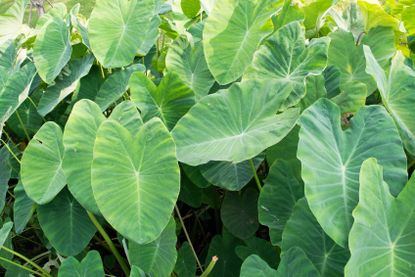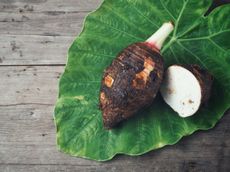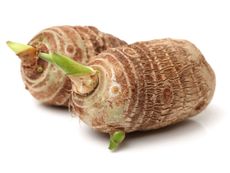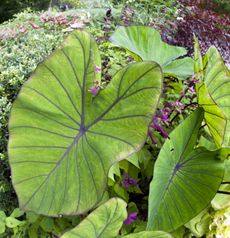Dividing Elephant Ears: How And When To Divide Elephant Ears


The name elephant ears is normally used most often to describe two different genera, Alocasia and Colocasia. The name is simply a nod to the giant foliage these plants produce. Most rise from rhizomes, which are fairly easy to divide. Elephant ear division is useful to prevent overcrowding, produce more plants in a different location and enhance plant health. It is important to know when to divide elephant ears, as the parent can become injured and pups may not perform well if divided and planted at the wrong time. Read on to learn how to divide elephant ears successfully.
When to Divide Elephant Ears
Elephant ears can become huge plants with gigantic leaves. Many spread through underground runners, or stolons, and send up baby plants along the way. These babies can be separated from the parent plant and installed elsewhere. Dividing elephant ears requires sterile, sharp instruments to prevent transferring disease and causing injury. Elephant ear division isn't necessary, but it helps rejuvenate old plants that may be performing poorly. Elephant ears are not frost tolerant and should be dug up in zones lower than United States Department of Agriculture zone 8. You can pot them up and bring the container indoors or remove the rhizomes and store them in peat moss, packing peanuts, or paper bags in a cool, dark place. Wait until the leaves die back during the cool fall months before lifting the rhizomes. At this time, it is a good idea to divide the plant. Since it is not actively growing, the plant will be less stressed than if you divide it while it is in full growth mode. Additionally, it makes it easier to handle without the large leaves getting in the way.
Tips on Dividing Elephant Ear Plants
Anytime you are cutting into a plant, it is a good idea to use the correct tools which are sharp and clean. When dividing elephant ears plants, you can use a knife or shovel, whichever you find easiest. Wash the tool with a 5% solution of bleach and make sure it has a keen edge. If the plant is in a container, remove it entirely and brush off the soil around the roots and rhizomes or tubers. For in-ground plants, dig carefully around the root zone and gently lift the entire plant out of the soil. Place it on a tarp and remove the excess soil to expose your work site. Next, look at the individual pups to decide which ones to remove. They should have healthy rhizomes and good roots to have a chance of survival off of the parent plant.
How to Divide Elephant Ears
Dividing elephant ears is easy! Once you have selected your pups, it is time to remove them. Use a sharp knife or your shovel and bisect the section away from the parent. Tubers cut cleanly with a texture like a potato. Rhizomes are separated from the main mass. Ensure each new plantlet has a good root system already in place and the rhizome, or tuber, has no blemish or rotten area. You can plant them immediately in clean potting soil or hold them in a cool dark area, with temperatures no lower than 45 degrees F. (7 C.). Move potted pups to a sunny location indoors and keep them moderately wet. When temperatures warm up in spring, move the plants outdoors. Your collection of elephant ears has now effortlessly expanded and can be planted in the ground or kept in containers.
Gardening tips, videos, info and more delivered right to your inbox!
Sign up for the Gardening Know How newsletter today and receive a free download of our most popular eBook "How to Grow Delicious Tomatoes."

Bonnie Grant is a professional landscaper with a Certification in Urban Gardening. She has been gardening and writing for 15 years. A former professional chef, she has a passion for edible landscaping.
-
 Urban Composting Guide: How To Compost In The Middle Of The City
Urban Composting Guide: How To Compost In The Middle Of The CityUrban composting does not have to be daunting. You can compost in the city, and maybe even try some urban worm composting!
By Mary Ellen Ellis
-
 Shrub Diseases And Pests To Watch Out For
Shrub Diseases And Pests To Watch Out ForShrub diseases and pests can be challenging. Learn how to recognize and eradicate them before they can present a danger to your plants.
By Susan Albert
-
 Can You Grow Taro In A Pot – Container Grown Taro Care Guide
Can You Grow Taro In A Pot – Container Grown Taro Care GuideTaro is a water plant, but you don’t need a pond or wetlands in your backyard to grow it. You can successfully grow taro in containers if you do it right. Click here and learn how to grow this plant in containers so you can enjoy the pretty tropical wherever you are.
By Mary Ellen Ellis
-
 Elephant Ear Plant Disease In Gardens: How To Treat Sick Elephant Ears
Elephant Ear Plant Disease In Gardens: How To Treat Sick Elephant EarsElephant ears are often grown for their huge, robust foliage. The leaves are prone to several diseases which mar this ornamental appeal. There are also diseases that can cause crown and root rot. If your plant has disease symptoms, this article can help.
By Bonnie L. Grant
-
 Elephant Ear Control – Ridding The Garden Of Unwanted Elephant Ear Plants
Elephant Ear Control – Ridding The Garden Of Unwanted Elephant Ear PlantsElephant ear plants are most often grown in cooler climates as an annual where they do not become a problem. However, in hot, humid, tropical locations, one little elephant ear plant can all too quickly become a mass of them. How do you get rid of elephant ears? Find out here.
By Darcy Larum
-
 Growing Taro For Food: How To Grow And Harvest Taro Root
Growing Taro For Food: How To Grow And Harvest Taro RootAnother healthier option to the standard potato chip would be growing and harvesting your own taro roots and then turning them into chips. Want to find out how to grow and harvest taro in your own garden? This article will help get you started.
By Amy Grant
-
 Elephant Ear Plant Types: Learn About Common Elephant Ear Plants
Elephant Ear Plant Types: Learn About Common Elephant Ear PlantsElephant ears are one of those plants whose foliage receives double takes and oohs and aahs. There are different elephant ear plants in four genera available for growing in your landscape. Learn more about them in this article.
By Bonnie L. Grant
-
 Elephant Ear Problems: What To Do With Elephant Ears Taking Over Garden
Elephant Ear Problems: What To Do With Elephant Ears Taking Over GardenDo elephant ears affect nearby plants? There are no allelopathic properties in the corms, but this can be an invasive plant and the excessive size may pose problems for species that live under the giant foliage. Learn more in this article.
By Bonnie L. Grant
-
 Uses Of Dasheen Plants: Learn About Growing Dasheen Taro Plants
Uses Of Dasheen Plants: Learn About Growing Dasheen Taro PlantsYou probably have already heard of dasheen, just with a different name: taro. Check out this article for interesting dasheen plant info including what is dasheen good for and how to grow dasheen. Click here for more.
By Amy Grant
-
 Elephant Ear With Brown Edges: Why Do Elephant Ear Plants Get Brown On Edge
Elephant Ear With Brown Edges: Why Do Elephant Ear Plants Get Brown On EdgeYou can't ask for more visual impact than the large leaved Colocasia, or elephant ear plant. That said, leaf browning on elephant ears is a common complaint. Why do elephant ear plants get brown on edge? Find out in this article.
By Bonnie L. Grant